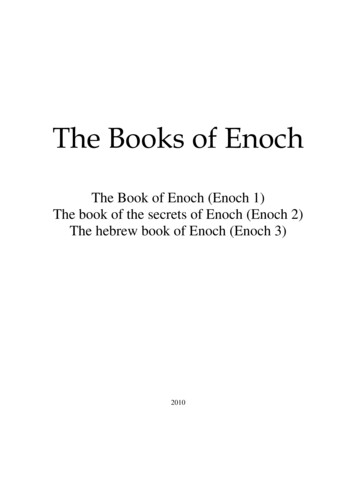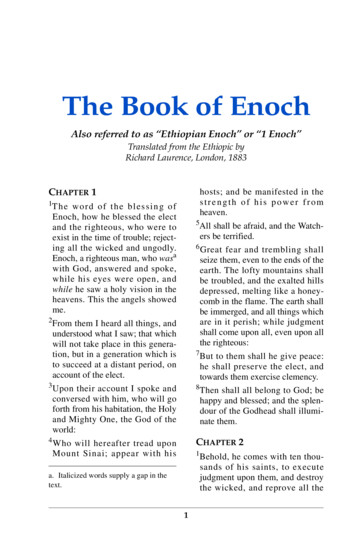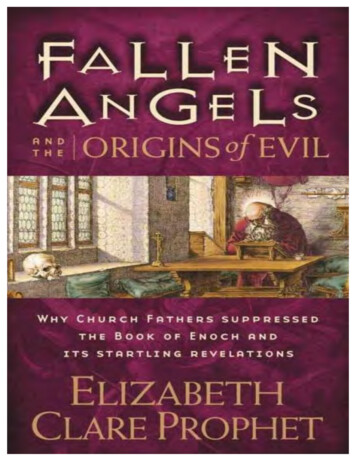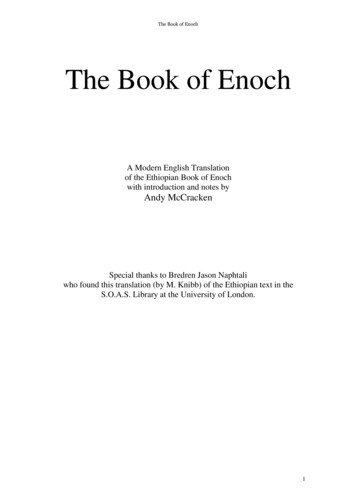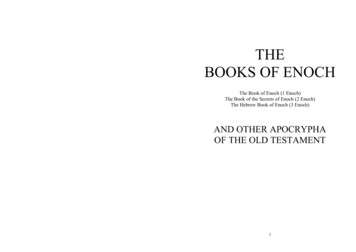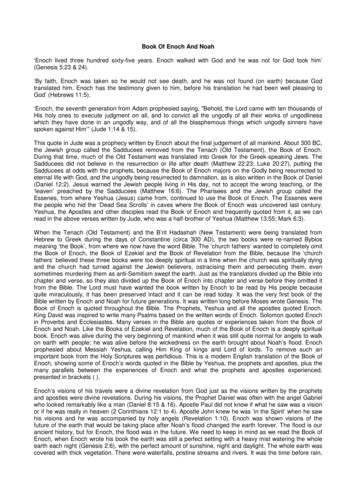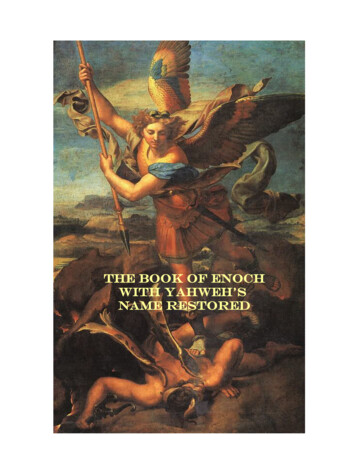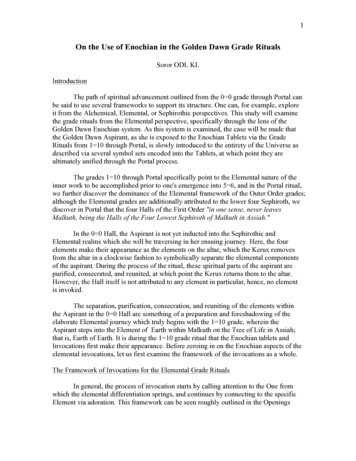
Transcription
This is a reproduction of a library book that was digitizedby Google as part of an ongoing effort to preserve theinformation in books and make it universally accessible.https://books.google.com
\81 oPi 3
THEBOOKOFENOCHTRANSLATED PROM THE ETHIOPIC,INTRODUCTION AND NOTES.BYEev. GEOEGE H. SOHODDE, Ph.D.PROFESSOR IK CAPITAL UNIVERSITT, COLUMBUS, OHIO.WARREN F. DRAPER.1882.
5- Z&-/JZ3Entered according to Act of Congress, in the year 1882, byWARREN F. DRAPER,in the Office of the Librarian of Congress at Washington.
PROF. FRANZ DELITZSCH, D.D.,Leipzig, Germany,atth to my feaiir l rif irirfPROF. EZRA ABBOT, D.D.,Cambridge, Mass.425962
PREFACE.Scarcely any department of theological science has,in the last few decades, received such marked attentionand cultivation as that branch for which the Germanshave adopted the felicitous appellation Neutestamentliche Zeitgeschichte, — the study of the age of Christ inits political, social, and religious aspects. Observantreaders will not have failed to detect that the tendencyof modern evangelical theology is to transfer the centreof interest from the work of Christ to the person of Christ.Hand in hand, and in close connection with this generaltendency, certain auxiliary branches have assumed animportance hitherto not attributed to them. When theperson of Christ forms the cynosure of all eyes, hissurroundings proportionally grow in interest and importance ; and hence it is not surprising that so muchacumen and learning have been employed in the trulyfascinating study of the Palestine of Christ's day in allits relations. The central sun casts its rays of resplendent light on every-day objects, and these become prominent in proportion as they reflect this light.In more than one respect the Book of Enoch is an
viPREPACE.important factor in these investigations. Being one ofthe oldest specimens of apocalyptic literature ; reflectingin its different parts the convictions, feelings, and longings of the people of God at different stages of theirdevelopment ; written in imitation of the spirit of theprophets, with religious purposes and spiritual objects ;it can safely be said to be an invaluable aid to theunderstanding of the religious and moral atmosphere inwhich the Saviour lived. It does not belong merely tothe curiosities of literature, but is a book of positiveworth, and the source of much information to the patientinvestigator.This will suffice as an apology for a new translation ofEnoch. In the translation the object has been to renderas literally as possible, even if thereby the English shouldbecome a little harsh. Of course the notes do not pretend to unravel all the mysteries in this most mysteriousof books ; but it is hoped they will be of some assistancein understanding these intricacies. Naturally, theseand the Introduction are, in part, a compilation ; butthe thoughts of others have been used with judgmentand discrimination, and the sources are indicated. Inall questions the writer has been independent, as will beseen by the fact that he has frequently departed frombeaten paths.Much remains yet to be done before this book will beentirely understood. Both its connection in sentimentand expression with the Old Testament, as well as its
PREFACE.viiinfluence on Talmudic and Rabbinical lore, especiallythe latter, must, to a great extent, be the work of futureinvestigations. But even with the limited means at handthis book, which an inspired writer thought worthy ofcitation, will not be read by the Christian theologianand minister without deep interest.In conclusion the translator desires to express histhanks to his friend Prof. Dr. Adolf Harnack, ofGiessen, Germany, for kind words and deeds in connection with this work ; and to Prof. Dr. Ezra Abbotfor his interest and aid in its publication.GEORGE H. SCHODDE.Columbus, Ohio, Nov. 21, 1881.
GENERAL INTRODUCTION.EnoCh (Tpn , lxx 'Evco ) is the name of four biblicalpersons. The first is the oldest son of Cain (Gen. iv.17) ; the second, the son of Jared (Gen. v. 18) ; the third,the son of Midian (Gen. xxv. 4) ; the fourth, the oldest son of Reuben (Gen. xlvi. 9; Ex. vi. 14) .* Of thesethe second alone is of importance and interest for us,not only on account of the mysterious prominence givenhim in Gen. v., but especially from the fact that an inspired writer of the New Testament, Jude, in his letterver. 14, mentions him as a prophet, and produces a quotation from a book attributed to the patriarch. Theexistence of such a book does not, however, rest on theauthority of this statement alone ; but in the early literature of the church there is a whole chain of evidencesto this effect. Nearly all of the church Fathers knewof an apocryphal Book of Enoch, and their descriptionof the work and citations from it prove satisfactorily thatit was virtually the same as that which now lies before us.Among the Apostolic Fathers, the Epistle of Barnabasrefers to such a work. In chap. iv. 3 of that letter,Enoch is cited, and the character of the quotation pointsto chap. 80 of our book as its probable source, while inthe statement of the same Epistle xvi. 5, although in1 The lajt two are transcribed in the authorized version Hanoch, theothers Enoch.1
2GENERAL INTRODUCTION.troduced with the important words : \eyei yap f] ypatyq,we find almost the very words of En. 89 : 56. Fromthat time on to about the seventh century Christian literature, to which alone we owe the preservation of theimportant work, produces ample proof of the constantuse and high standing of this book. Beside the JewishChristian Testament, xii Patriarch.? a production of thesecond century, the church Fathers 2 Justin Martyr,3Clemens of Alexandria,4 Origen,5 Irenaeus,6 Tertullian,7Eusebius, Jerome, Hilary,8 Epiphanius,9 Augustine, andothers refer to and use it.10 The majority of these statements are indeed simply allusions and general references ; but they are of such a character that their sourcein the present Book of Enoch can generally be found to acertainty, the writers in this respect following the example of Jude, whose citation is taken from En. 1 : 9,and is not a literal reproduction. The Fathers all,with possibly the one dissenting voice of Tertullian (DeCult. Fem. i. 3), deny the canonicity of this book, andproperly regard it as apocryphal ; some going even sofar as to deny the canonicity of Jude because he haddared to quote an apocryphal work.11 The precedentfor this step was given in the Apostolic Constitutions,vi. 16, in strong words. When, after the time of Au1 Cf. on 2 : 1 ; 15:5; 19:2; 25 : 5 ; 61 : 10 ; 89 : 50.2 Their references have been collected and discussed in Fabricius, CodexPscudepigraphus Vet. Test. vol. i. 1722, pp. 160-224, and in Philippi, DasBuch Henoch, 1868, p. 102-118.8 Cf. on 15 : 8, 9 ; 16 : 2.4 Cf. on 8 : 3 ; 16 : 2 ; 19 :3.6 Cf. on 6 : 5, 6 ; 19 : 1, 3 ; 21 : 1.8 Cf. on 10 : 3 ; 14:7.I Cf. on 8 : 2 ; 16 : 2 ; 19 : 1 ; 82 : 3 ; 99 : 6, 7.8 Cf. on 6 : 6.9 Cf. on 6 : 6; 16 : 2.10 Cf. the discussion of these in Hoffmann, Das Bach Henoch, 1830-38,pp. 887-916.II Cf. Jerome, Catal. Script. Eccles. 4.
GENERAL INTRODUCTION.3gustine, tho period of literary death robbed the churchof many of her noblest monuments of literature, theBook of Enoch, too, was lost, and later investigators hadto be content with the references in the Fathers, and afew extracts made by the learned monk of the eighthcentury, Georgius Syncellus, in his Chrouography.1 Ashort time after him, in the ninth century, the book ismentioned as an apocryphon of the New Testament bythe Patriarch Nicephorus.2 The fragments preservedby Syncellus, varying indeed in minor points of expression, are still virtually an extract from the book as wehave it now. They are divided into two parts ; thefirst containing chap. 6 : 1 to chap. 9 : 4, the secondchap. 8 : 4 to chap. 10 : 14, and chap. 15 : 8 to chap.16 : 1 ; in addition to which there is a small part notfound in the Ethiopic. Here comes into considerationalso a small fragment of the Greek Enoch found afterthe discovery and publication of the Ethiopic version.We refer to the Greek text of chap. 89 : 42-49, written with tachygraphical notes, and published from aCodex Vaticanus ( Cod. 6rr.l809) in facsimile, by AngeloMai in Patrum Nova Biblioiheca, vol. ii. These verseswere deciphered by Prof. Gildemeister, who publishedhis results in the Zeitschrift d. Deutsch. Morgenldnd.GeseUscha/t, 1855, pp. 621-624. In Jewish literature,the Book of Enoch did not stand in such high regard asit did among Christian writers, and consequently wasnot so extensively used. -It was, however, neither unknown nor ignored altogether. Already in the workso frequently cited in early Christian literature as Ta'IwfirjXcua or 77 Xe-n-Trj yiveaK, a production of the first1 Published in Dillmann's translation, pp. 82-86.2 Cf. Niceph. (ed. Dindorf), 1. 787.
4GENERAL INTRODUCTION.Christian century, the references are frequent and unmistakable.1 A comparison of the statements of thisbook of the Jubilees, especially p. 17 sq. of the Ethiopictext (ed. Dillmann), with those of Enoch forces us tothe conclusion that the author of the former book couldnot have written as he did without an exact knowledge of the contents of the latter. Of the use made ofthe book by later Jewish writers, we have a brief account by A. Jellinek in the Zeitschrift d. D. M. O.1853, p. 249. The clearest example in this respect isfound in Sohar, vol. ii. Parasha nbea p. 55 a (ed. Mant.et Amsterd.) : " Comperimus in libro Hanochi, Deumilli, postquam, sustulisset eum in sublime, et ostendissetei omnes thesauros superiores et inferiores, monstrasseetiam arborem vitae et arborem illam, quam interdixerat Adamo, et vidit locum Adami in Paradiso, inquo si Adamus observasset praeceptum illud, vixissetperpetuo et in aeternum mansisset." In vol. i. Parasha Bereshit, p. 37 b there is a remark that coversabout the same ground, with the additional statementthat the Book of Enoch was " handed down " to himfrom the time when he began to associate with superterrestrial beings.2The existence of such a Book of Enoch, made certainfrom these numerous quotations, was the source ofconsiderable perplexity and anxiety to Christian theologians, and numerous and curious were the conjecturesconcerning its authorship and character. In the be1 Ronsch finds nineteen such references in the book of the Jubilees. Cf. Drummond, The Jewish Messiah, p. 71.2 The Hebrew text of this quotation is found in Philippi, 1. c. p. 121.According to Philippi's statements there are also references to Enoch inthe Assumptio Mosis, a fragmentary production of the first or second century, a.d., and in 4 Ezra and in the Sibylline Books. Cf. I.e. p. 105 sq.
GENERAL INTRODUCTION.5ginning of the seventeenth century it was confidentlyasserted that the book, mourned as lost, was to be foundin an Ethiopic translation in Abyssinia, and the learnedCapuchin monk Peirescius bought an Ethiopic bookwhich was claimed to be the identical one quoted byJude and the Fathers. Ludolf, the great Ethiopic .scholar of the seventeenth and eighteenth centuries,however, soon proved it to be a miserable production ofa certain Abba Bahaila Michael.1 Better success attended the efforts of the famous English traveller JamesBruce, who discovered three copies of the book, andbrought them, in 1773, with him to Europe.2 One ofthese found its way into the Bodleian Library, the otherwas presented to the Royal Library of Prance, the thirdwas kept by Bruce. Since that time other copies have *been brought from Abyssinia. Strange to say, no usewas made of these important documents until the year1800, when Silvestre de Sacy, in his Notice sur le limed1Enoch, in the Magazin Encyclopidique, an vi., tomeI. p. 382, gave as specimens of the book the extractsand Latin translation of chap. 1 and 2, chap. 5-16, andchap. 22 and 32, from which then, in 1801, a Germantranslation was made by Rink. There again the matterrested until 1821, when Prof. Laurence, afterwards Archbishop of Cashel, published an English translation fromthe ms. in the Bodleian, with the title : " The Book ofEnoch, the Prophet: an apocryphal production, supposed to have been lost for ages ; but discovered at theclose of the last century in Abyssinia ; now first translated from an Ethiopic MS. in the Bodleian Library.Oxford, 1821." The second edition of this work ap1 Cf. Ludolf, Commentarius in Hist. Aethiop., p. 347.2 Cf. Bruce, Travels, vol. ii. p. 422 sq.1*
6GENERAL INTRODUCTION.peared in 1833, the third in 1838. In the same yearin which the third edition appeared, Laurence editedthe Ethiopic text as: " Libri Enoch Prophetae VersioAethiopica." Both text and translation are unreliable, and must now be regarded as entirely antiquated.1Laurence's text is divided into one hundred and fivechapters, which division was accepted by investigatorsdown to Dillmann. lie very properly made the divisioninto one hundred and eight chapters. Prof. A. G. Hoffmann, of Jena, issued a full translation of Enoch withcopious notes, in two parts, as : Das Buck Henoch invoUstandiger Debersetzung, mit fortlaufendem Commenrtar, aus/iihrlicher Einleitung und erlauternden Excursen.For Part I., chap. 1-57, issued 1833, Hoffmann coulduse only Laurence's text and translation, but for PartII., chap. 58-108, he, in addition to these aids, consulteda ms. copy brought by Dr. Riippell from Abyssinia anddeposited in Frankfurt am Main. In the second partmany of Laurence's mistakes are corrected, but not allby any means. With these aids at his disposal, Gfrorermade his Latin translation of the book in 1840, as :" Prophetae veteres Pseudepigraphi, partim ex Abyssinico vel Hebraico sermonibus Latine versi " ; but thiswas again unsatisfactory. The book of Rev. EdwardMurray, " Enoch Restitutus, or an Attempt," etc., London, 1836, must be regarded as a total failure.2 Allthese sins were atoned for when the master-hand of A.Dillmann issued the Ethiopic text in 1851, as: " LiberHenoch, Aethiopice, ad quinque codicum fidem editus,cum variis lectionibus." 3 Two years later the same1 Cf. the severe judgment on Laurence by Dillmann, Das Bitch Henoch,p. lvii.s Cf. Hoffmann, Zweiter Excurs, pp. 917-965.8 From this edition our translation has been made.
GENERAL INTRODUCTION.7author published his accurate translation of the book,with reliable notes, as : Das Buch Henoch, iibersetztund erMdrt, a work of singular acumen and vast learning, which is the standard translation of Enoch to thisday. The publication of these two works inaugurateda series of happy studies by Liicke, Ewald, Kostlin,Hilgenfeld, Volkmar, Langen, Gebhardt, Tideman, andothers, who have all sought to give solutions of themany difficulties presented by this most mysteriousbook, but with very different results.1' Before proceeding to the special examination andanalysis of the book before us, it is highly importantthat the question of the trustworthy or untrustworthycharacter of the Ethiopic translation be discussed. Isthe Ethiopic translation a reliable version of the GreekEnoch ? For it is evident that the translation belongsto the early period of Ethiopic literature, when the literature in the Greek language was copied and translated by the Abyssinian theologians, before the introduction of Arabic influence and models. Enoch is, then,like all of the best specimens of literature in Abyssinia,— the Bible, the Book of the Jubilees, the fourth Bookof Ezra, Ascensio Isaiae, and Pastor Hermae, — translated from the Greek. Whether the Greek is the original language of the book, or the Hebrew or Aramaic, willbe discussed later ; here we have to decide on the relation existing between the Ethiopic and the Greek, fromwhich our Enoch is a translation. As the Greek text,with the exception of some fragments, has been lost,this question cannot be apodictically decided, but thereare means of reaching a probable result, sufficient to1 The results of these investigations will be mentioned and used in theSpecial Introduction and in the Notes.
8GENERAL INTRODUCTION.permit us to trust the text as we find it in the Ethiopictranslation. This result can be reached in two ways,first by analogy, by seeing whether those translationsof which the original Greek has been preserved arefaithful representatives of these originals, and thuslearning the general manner in which translationswere made in Ethiopia, and secondly by comparing thefragments of Enoch that still remain with the translation. Following the first method, we naturally beginwith the comparison of the version of the Bible, translated in the early days of Christianity among theEthiopians, not from the Hebrew, but from the Septuagint. Here only one authority has a right to speak,the editor of the Octateuchus Aethiopicus, Prof. Dillmann. As late as 1877, after years of diligent researchon this subject, his judgment of this translation and itsrelation to the Greek is as follows : 1 " With regard tothe translation, it must be said that it is a very faithfulone, generally giving the Greek text verbatim, ofteneven the relative position of the words ; it abbreviatesonly now and then whatever seemed superfluous, andmust, on the whole, be called a successful and happyversion. Notwithstanding its entire fidelity to theGreek text it is very readable and, especially in thehistorical books, smooth, and frequently coincides withthe meaning and words of the Old Testament in a surprising manner. Of course there is a difference in thisrespect between the different books. The Ethiopictranslators were by no means very learned men, andhad not an absolute command of the Greek language ;especially when they had to translate rare words andtechnical terms this clearly appears, and consequently1 Cf. Herzog, Real-EncyklopSdie (2d edition), vol. i. p. 204.
GENERAL INTRODUCTION.9some misunderstandings and mistakes have crept intothe text through the fault of the translators." Thisversion of the Old Testament is, then, on the whole, afaithful copy of the Septuagint.The same must be said of the translation of PastorHermae, although here " the sins of omission " aremuch more frequent, especially in Similitudines iv., v.,and vi., which are rather an epitome of the Greek thana translation. Positive mistakes do, indeed, now andthen occur,1 but the main deviations from the Greekare found in the omissions. These are by no means ofmuch importance as to contents, except possibly inSim. v. 2, and it would be difficult to decide who madethese omissions, whether they were already found inthe original of the translator, or introduced by him, orare to be ascribed to a copyist.2 A close comparisonbetween the Ethiopic and the Greek text proves conclusively that the former is what can be called a goodtranslation.As the Greek text of the Physiologus has never beenissued in & critical edition, a reliable examination of thefidelity of the old Ethiopic translation can scarcely bemade, yet the evidences seem sufficient to justify anopinion equally as favorable as that passed on the version of the Bible and on Pastor Hermae.3The Greek text of the Ascensio Isaiae recently discovered, and published by Gebhardt in Hilgenfeld'sZeitschrift fiir wissenscha/l. Theologie, 1878, pp. 330353, is evidently a different recension from the one1 Cf. Dillmann, in Zeitschrift d. D. M. G. xv. p. 121 sqq.2 Cf. Patres Apostol. ed. Gebhardt, Hamack et Zahn, Prolegomena toHernias, p. xxx.8 Cf. Hommel, Die Aetkiop. Uebersetzung des Physiologus, etc., 1877, p.xliii, sq.
10GENERAL INTRODUCTION.from which the Ethiopian made his translation, hence acomparison could produce but few positive results.From the evidences, then, that can be regarded asvalid we are, from analogy, allowed to expect that theEthiopic translation of Enoch will, on the whole, be afaithful one, although occasional mistakes and omissionsmay occur. This opinion is confirmed by an examination of the remaining fragments of the Greek text.Comparing our text with that of Syncellus it is atonce apparent that they do not always agree. But thisdoes not impeach the veracity of the Ethiopic, for Syncellus furnishes his own evidence that he did not quoteliterally, but in a free manner. Chap. 8 : 4 to chap.9: 4 he gives twice, and the two quotations are farfrom being alike, thus showing that Syncellus, in hisextracts from Enoch, as he was accustomed to do whenciting other works, does not pretend to quote literally,but simply to give the sense. Certainly Syncellus hasoccasionally, as in 6 : 6, the better text, but in otherplaces the Ethiopic wording, as the notes show, is decidedly to be preferred. This comparison, then, in nomanner injures the claim of the trustworthy characterof the version before us.Gebhardt1 has attempted to draw capital from theGreeTc fragment of 89 : 42-49, and on the basis of thesefew verses has reached a very pessimistic conclusion onthe Ethiopic text of Enoch, especially chap. 89 and90. But here there is really but one verse wherethe Greek presents a better reading,2 and this verse isof little importance, and can in no wise affect the con1 Cf. Merx, Archiv fur ivissenschafll. Erforschung des A. T., ii. 2, p.242 sq.2 Cf. Notes, Tideman, I.e. p. 282 sqq., reaches the same conclusion.
GENERAL INTRODUCTION.11elusion that we have in Enoch, as translated by theearly Ethiopic church, a faithful copy of the Greek.Consequently we can proceed to the examination of thebook itself with but little hesitancy.
SPECIALINTEODUCTIOiN".§ 1. The book of Enoch is an apocryphal work. Etymologically the word apocrypha does not, and originallydid not, possess the sensus in malam partem in which itis now generally us-id. ''Anr6icpv pov was, in contradistinction from avayvyvaxncofievov, i.e. read openly in acongregation, employed either to designate a book thatwas hidden, used only in private circles, or it signifieda book of which not only the origin was hidden or unknown, but whose contents were also, i.e. veiled in thelanguage of allegory, symbolism, and other figurativespeech.1 Canonical and apocryphal are then not inthemselves contradictory terms, and a book could beboth at the same time. Hence, too, we can easily understand how Epiphanius can call the Revelation an airoKpv j}ov without thereby casting the least reflection on itsapostolic origin and canonical authority.2 Althoughthe Old Testament books now called apocrypha werereceived with some suspicion by the early Fathers, practically they were regarded as of equal authority withthe canonical writings. Only Jerome, in his PrologusGaleatus to Samuel, assumes an opposing position, andcalls them apocrypha ; but the merit of making this1 Cf. Schiirer in Herzog, R. E. (2d ed.), vol. i. p. 484.2 Cf. Volkmar, Das vierte Buch Esra und apokal. Geheimnisse itberhaupt.p. 2.12
SPECIAL INTKODUCTION.13word synonymous with non-canonical remained forOarlstadt, who seized on Jerome's idea and developedit in his tract, De canonicis scripturis libellus, 1520.Since that time the Protestant church has used thisword in this latter sense.1 In the English Bible theword Apocrypha was not used for these books until thesecond edition of Cranmer's Bible in 1549, while in thefirst edition, in 1539, and Matthew's translation, 1537,they are still called Hagiographa.2Of these apocryphal works one species is embracedunder the term apocalyptic. This latter class is ofa prophetic character, and under the assumption of asuperhuman source of information seeks to unravel themysteries of the present and the future. The contentsare generally of a strictly religious character, and containrevelations concerning the kingdom of God and its development, but also discussions of theological questions,such as the relation existing between man's sin andGod's justice, and explanations of the wonderful workings of God in nature and its laws. The incitementto the composition of such pseudo-prophecies must notbe sought for so much in a morbid curiosity and a fanciful imagination as in an anxious desire to ijnderstandthe workings of Providence, or even in a doubt concerning the promises given of old. They frequently owetheir existence to the birth-throes of the persecuted anddespairing children of God. Consequently the objectis generally an apologetic and exhortative one. Bothin contents and form they differ from the propheticbooks of the old covenant. While these latter form a1 Cf. Schiirer, I.e., and the different Introductions to the Old and NewTestament.2 Cf. Kitto, Cyclopaedia of Bibl. Lit. (3d ed.), i. 168.2
14SPECIAL INTRODUCTION.collection of prophecies, or anthology of different prophecies uttered at different times, and are often unchronologically arranged, the apocalyptic writings generallycontain a chain of such prophecies closely connectedwith each other. In form the enigmatical method ofpresentation is followed. Symbolical representationsand figurative speech in general are employed, namesand dates that could disclose the true author and histime are studiously avoided, and to give the whole theimpress of antiquity and authority the most notable andpious 1 in the history of Israel are made the bearers ofthese revelations. All these works, to a greater or lessextent, connect with the book of Daniel as the first andtypical apocalyptical writing, and, like it, direct the suffering faithful from the afflictions of their own times tothe speedy inauguration of the Messianic times, as theperiod when their hopes shall be realized and the promises of God redeemed.That one specimen of this peculiar literature isascribed to Enoch can certainly be no surprise, as theenigmatical words in which his history is recordedGen. v. 21-24 was a valuable possession in the handsof an apocalyptic writer. The statements there leftample room for a vivid imagination to supply unwrittenhistory, while antiquity and piety made Enoch a welcome name to give force and authority to a book, andthe " walking with God " of Enoch and his translationto heaven, which correct exegesis has always read inthis passage,2 founded his claim of having enjoyed close1 Thus we have the Apocalypse of Baruch, the Assuraptio Mosis, theAscensio Isaiae, Fourth Ezra, and here the book of Enoch.2 Enoch is not again mentioned in the canonical books of the Old Testatament, but twice in the Son of Sirach, xliv. 16 and xlix. 4, and in bothpassages the " and he was not " is regarded as synonymous with trans
SPECIAL INTRODUCTION.15communion with God and having possessed superhumanknowledge. That the n-nbtuvrw ?jbnmi is conceived byour author as a retirement from the earth to the regionof higher angelic beings, and the acquisition of superhuman knowledge there, is clear from En. 12 : 2,1 andthe method of receiving revelation is shaped accordingly, Enoch receiving his information not so much bydreams and visions as the prophets of old, but ratheron a tour in company with the angels made to the endsof the earth and the heavens. In the Parables, 37-71,however, this does not so much exert an influence onthe manner of acquiriug heavenly wisdom, althoughthe close communication with the angels is theretoo a prominent characteristic. The number of yearsin Enoch's life being three hundred and sixty-five, corresponding to the number of days in a solar year, thisfact suggested the idea of making him the bearer of allkinds of secrets concerning nature and its operationsand laws. Whether our author thereby gave expression to an ancient tradition among the people or originated the idea must, in the nature of the case, remaindoubtful, although the former might seem probable, asa writer of the first century B.C., Alexander Polyhistor,as quoted by Eusebius, Praeparatio Evangelica, ix. 17,5 (ed. Heinichen, vol. ii. p. 21), contends that Enoch firstdiscovered (evpijicevcu irpSirov) astrology (astronomy),lation into heaven, proceeding from the correct assumption that the wordISyst! , Oen. v. 24, forms a contrast to the well-known DB','l, used whenspeaking of the death of the other patriarchs. The same view is expressed by the LXX on Gen. v. 24, by Josephus Antiq. ix. 2, 2, by theauthor of the Epistle to the Hebrews xi. 5, the Targum of Jonathan, 1Clem, ad Cor. ix. 3, and early writers in general. For the view of theother Targumim, and the Oriental versions, see Pichard, Le Livred'Henoch sur I'amitig, p. 23 sq.1 Cf. also Liber Cosri (ed. Buxtorf), p. 153.
16SPECIAL IXTBODUCTION.over against the claims of the Egyptians. In harmonywith this claim is the tradition recorded by Josephus,Antiq. i. 8, that Abraham first brought the knowledgeof astronomy and arithmetic from Chaldea to Egypt,and from there they were then transplanted to Greece.Accordingly later Jewish tradition has made Enochnot only the father of arithmetic and astrology, butalso the inventor of the alphabet and the first author,to whom many books were ascribed.1 Thus we read ofthe " books " of Enoch in the Book of the Jubilees, Test.xii. Patriarch. ; Origen, c. Celsum v. p. 267, and Homil.28 in Num. 34 ; Augustine, Civ. Dei, xv. 23 ; Jerome,Script. Eccles. 4 ; and Georgius Syncellus quotes fromthe first book of Enoch concerning the watchmen. Withhis literary fame walked hand in hand his renown forpiety, so that the translated Enoch is even made theMetatron i.e. fiera dpovov or chief of those angels thatstand before the throne of God.2Among Mohammedan writers Enoch stood high asan inventor and literary character. In addition to thediscoveries attributed to him by Jewish tradition, Moslem fame honors him with the invention of sewing.3He is mentioned but once in the Koran, in Sura xix.57, under the name of Edris, i.e. the learned, and iscalled a prophet. Beidawi, the best Arabic commentator on the Koran, remarks on this passage that noless than thirty divinely revealed books were ascribedto his authorship.4 Of the writings attributed to this1 Cf. Winer, Bibl. Realtvorterbuch, Art. " Henoch."1 Cf. Tary. Jonath. to Gen. v. 24, an
book ofthe Jubilees, especially p. 17 sq. ofthe Ethiopic text (ed. Dillmann), with those of Enoch forces us to the conclusion that the authoroftheformerbookcould not have written as he did without an exact knowl edge of the contents of the latter. Ofthe use madeof the
